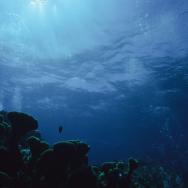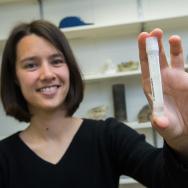Nowadays we’re getting more used to the idea that entire ecosystems of tiny bacteria are living on our skin, in the soil of our gardens and within the oceans where we catch dinner.
But one aspect that’s remained underexplored is the ecosystems of those ecosystems. Bacteria get viruses, too—and new research from scientists at the University of Chicago explores what role these viruses may play in the giant global recycling system that makes up the planet’s climate.
“There are ten billion viruses in every liter of seawater. We’ve known that for at least 20 or 30 years, but we have very little idea of what they’re doing and how they affect global carbon cycles,” said co-lead author Maureen Coleman, an assistant professor of geophysical sciences whose pioneering research explores the interactions between microbes, ecology and climate.
In a new study published July 15 in the Proceedings of the National Academy of Sciences, scientists showed that cyanobacteria infected with viruses continue to pull nitrogen out of the environment and channel it into making more viruses. The finding is an important discovery in the emerging field of what is called virus biogeochemistry—how viruses shape the movements of nutrients through the air, water and soil and thus, the Earth’s climate.
Bacteria are the reason we’re here. Once upon a time, they transformed the earth from a stark, empty world by quietly, patiently photosynthesizing oxygen over billions of years. They still play an enormous role in the world’s climate, moving nitrogen, carbon, and other nutrients into and out of the atmosphere and oceans.
But because they’re so tiny and so multitudinous, there’s much we don’t understand. For example, we know for every bacterial cell, there are tons more viruses—and these viruses are infecting bacteria, affecting their actions and competing for nutrients. For example, viruses hijack a cell’s biosynthetic factories and force them to make more copies of the virus, which are then released to spread the infection. How does this affect the cell’s takeup of carbon or other important nutrients?
The researchers wanted to know how viruses would change bacteria’s use of nitrogen, a key nutrient in all cells. They started with a particularly important class of bacteria called cyanobacteria, which live in oceans and waters all over the world and do an enormous amount of the world’s photosynthesis and carbon fixation.
“Half of all carbon fixation happens in the oceans, and cyanobacteria are an extremely important player in that cycle,” said Jacob Waldbauer, Neubauer Family Assistant Professor and co-lead author of the study. “We need a basic understanding of what affects their function and productivity, and we know very little about what roles viruses play.”
To learn more, the researchers fed cyanobacteria with nitrogen, infected some with viruses, and then put them in a bath containing a different type of nitrogen. That meant they could track exactly how much nitrogen the cell took up after it was infected, and where it was used.
The results were clear: The infected bacteria took up a large amount of nitrogen. All of it went into manufacturing more viruses—none went into making proteins for the host cell.
Previously, Coleman said, many assumed that viruses just cannibalized nutrients from their host cells. “We’ve not appreciated that it also acquires nutrients for its own purposes from the environment,” she said. “It’s clear the virus is reprogramming host cells in ways that might have consequences for the fates of nutrients in the system.”
There’s much more to explore, the researchers said. For example, they want to know if an infected cell takes up more nitrogen than a healthy one; whether different kinds of viruses have different effects; and how the whole thing is affected by temperature—important as the oceans start to warm up.
“There’s much more to the story,” Coleman said. “But even from this study, it’s clear they change how ecosystems use nutrients—and that we need to know how if we want to fully understand climate.”
Other University of Chicago scientists on the paper were research technicians Kathryn Campbell and Lichun Zhang, as well as undergraduates Adriana Rizzo, SB’16 and John Lotus, SB’17.
Citation: “Nitrogen sourcing during viral infection of marine cyanobacteria.” Waldbauer and Coleman et al, Proceedings of the National Academy of Sciences, July 15, 2019. DOI: 10.1073/pnas.1901856116
Funding: Gordon & Betty Moore Foundation Marine Microbiology Initiative, Simons Foundation.

